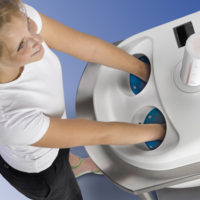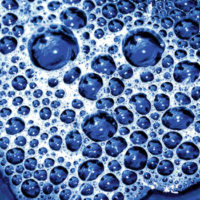We all know the importance of personal hygiene practices in the prevention of foodborne diseases. The washing of hands has become an industry unto itself. A Google web search of "hand washing" brings forth no less than 1,090,000 responses. A lot of these sites are related to current epidemic disease prevention initiatives. Many offered information from our various governmental agencies specific to food safety and infection control. A significant number of sites are posted by companies selling hand washing aids, products, literature, training and monitoring programs, just to name a few. The wealth of information on hand washing is truly awe-inspiring. In the time it took to enjoy a cup of coffee, I was able to bookmark, and in some cases download, a number of PDF files, brochures, pictures and PowerPoint presentations--all about hand washing.
Yet, with all this information, I can still go into some commercial and institutional kitchens and find the hand washing sink as dry as dust or filled with soiled utensils, wipe rags, and in more than one case, a box of gloves (I guess that's a sign of good intentions). Even if the hand washing sink had all the necessary amenities, I remain unconvinced of its use when I see a cracked bar of soap and paper towels yellowed with age.
During my career as a sanitarian, I've participated in more than a few foodborne illness investigations. I can honestly state that in the majority of those outbreaks hand washing, or the lack thereof, was the major factor of disease transmission. If food safety professionals were given one wish, we would unanimously ask that the human species be given a re-evolution, with a dominant gene encoded for the characteristic of habitual and thorough hand washing. Instead, we were only given the cognitive skills to recognize a hand washing sink and all its accoutrements, not the innate knowledge and skill to use it properly or understand its necessity of purpose without extensive education and reinforcement. Ideally, proper hand washing should be habitual.
Not to disparage the many companies that make up the hand washing industry, but I am not alone in saying that most of us have tried posters, stickers, cute buttons, automatically timed faucets and sensors, hand washing and hand sanitizing compounds of varying composition, colors and flavors--all in an effort to change behavioral patterns. We have even resorted to giving incentives and rewards, as well as dishing out minced oaths and veiled threats when we've noticed a breach in personal hygiene. I must admit, all of these things work for a while. However, when enthusiasm wanes, the watchful eye slackens: When the posters, stickers, incentives and good-smelling soaps become commonplace, it is most often back to the old ways.
Degerming the Skin
Before I offer some suggestions on approaches to hand washing successes, I would like to put hand washing for food safety in its proper microbial context; specifically removal of the hand's bioload. To do this, let me introduce this objective as a series of priorities. The highest priority in the degerming of skin, is cleaning the skin to the lowest possible level of microbial contamination attainable. This means removing the transient superficial resident and subsurface resident microflora. We generally reserve this priority for pre-operating site preparation and burn patients. The second priority is removing the transient flora; in other words, removing most resident superficial organisms. Examples of this type of cleaning are surgeon's hands, injection sites and newborn skin. The third priority is to remove most transient microflora. This is hand washing for food safety. To meet this goal, hand washing in food preparation and service areas should be frequent and emphasize cleaning of the fingertips--after all, this is the part of the hand that touches the business end of toilet paper; raw poultry, vegetables and common fomites such as door knobs.
While I don't have the answers to achieving this priority of people cleanliness, I can report on some of the successes I've seen over the years and pass them on to you as helpful suggestions.
Better to build it in than to fit it in. Make hand washing part of the kitchen operation. All too often, hand washing is treated as a separate issue and not part of food preparation. Traditionally, inspections focused on walls, floors and ceilings, with the hand washing sink--not hand washing--as an inspection report item. Old habits are hard to break. The establishment inspected would always ensure soap, paper towels and a covered container is sitting on and next to the sink at all times to avoid a demerit score. The absence of a hand washing sink would bring down the wrath of the gods. I can recall seeing owners install a hand washing sink in lieu of the common two-compartment utility sink in older retail food establishments. In too many cases, the new hand washing sink was, for the most part, inaccessible and never used. Yet, it complied with regulations. The double-compartment unit still served as the lavatory, vegetable scullery, utensil washing and, in some instances, the housekeeping slop sink.
It finally dawned on me that integrating the hand washing sink into the work pattern of the kitchen, rather than location of "expedient best fit" is the only way to ensure its use. I first saw this demonstrated at an institutional kitchen in a state facility. The hand washing sink was next to the time clock with a simple pipe railing directing the path of travel from punching in to washing hands. It also was the same path of travel upon returning from the restrooms. Simple and effective: No one entered the kitchen without washing their hands, including vendors and maintenance personnel. While this may be an extreme example, it clearly demonstrates that hand washing sinks can be sited where they are both accessible and used. We cluster cooking equipment, so why not cluster preparation and hand washing equipment? I am convinced that cooks and sanitarians should design and lay out a kitchen, rather than architects and plumbers. The former has a primary consideration of ease of movement and food safety, while the latter considers expediency and ease of installation.
Better to teach than to preach. Teach the art of hand washing. Remember, this skill does not come naturally. With any skill, we do not become proficient by listening to a talking head or by reading a poster. We learn by doing, by demonstration, by repetition, by precept and example. Therefore, the best teaching tools are those that involve actual hand washing and some way to see the results.
I have used two methods successfully: one high-tech, one low-tech, but both use some visual marker as a surrogate for "germs." The high-tech method uses a kit consisting of an inexpensive ultraviolet (UV) lamp, and an oil or powder containing a fluorescing compound, which is easily seen under UV light. To demonstrate proper hand washing techniques, the oil containing tiny plastic fluorescent beads is applied to the hands in the same way as one would apply hand lotion. After normal hand washing, the hands are inspected with the UV lamp to detect any oil that was not washed off. This demonstrates quite graphically how good one's hand washing technique really is, without going into any long discussion on details. If the hands glow under UV light, they're not clean...period. The only problem you may encounter with this system is that the UV light may not be strong enough to effectively show residual oil when viewed in a properly lighted kitchen. To overcome this problem, use either a double-tube UV inspection lamp or simply fashion a "shadow box" from a shipping carton by folding in both end flaps.
It takes several days of consistent use to change behavior. However, the lesson is well-learned and worth the effort. As an aside, the fluorescing powder also can be used to visually see exactly "how clean is clean," but more on this in a subsequent article.
The low-tech approach is equally effective, but not quite as dramatic. Mix a colored spice such as cinnamon, sweet paprika or curry powder in cooking oil and use it in the same way as described above. The colored spice will show up nicely around and under the nails and between the fingers if the hands are not properly washed. In addition, the odor from the more aromatic spices such as cinnamon and curry will linger on the hands if not completely removed. Any colored powder will work equally as well. If an odor tracer is preferred, add a few drops of any essential oil, such as peppermint or spearmint.
Reinforcers, not enforcers. The goal is to get food handlers to habitually wash their hands before starting work and frequently during work. A timed bell (ringing at half- or one-hour intervals) to alert staff to visit the lavatory works well if the practice is consistent and with no deviation. However, if you want staff to frequently wash their hands voluntarily, consider a reward system; punishment rarely has a desired outcome. We all respond to praise and favors. Adherence to safe practices in industry is aided by use of incentives. Try it with hand washing, the results may surprise you.
Forensic sanitarian Robert W. Powitz, Ph.D., MPH, RS, CFSP, is principal consultant and technical director of Old Saybrook, CT-based R.W. Powitz & Associates, a professional corporation of forensic sanitarians who specialize in environmental and public health litigation support services to law firms, insurance companies, governmental agencies and industry. For more than 12 years, he was the Director of Environmental Health and Safety for Wayne State University in Detroit, MI, where he continues to hold the academic rank of adjunct professor in the College of Engineering. He also served as Director of Biological Safety and Environment for the U.S. Department of Agriculture at the Plum Island Animal Disease Center in Greenport, NY. Among his honors, Powitz was the recipient of the NSF/NEHA Walter F. Snyder Award for achievement in attaining environmental quality, and the AAS Davis Calvin Wagner Award for excellence as a sanitarian and advancing public health practice.
Dr. Powitz welcomes reader questions and queries for discussion in upcoming columns. Contact him at sanitarian@juno.com or through his website at www.sanitarian.com.




